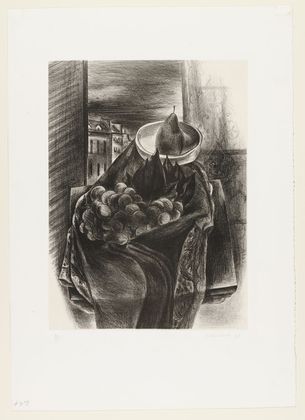Description
The work "Still Life In the "Yasuo Kuniyoshi window, painted in 1928, she is a captivating representation that fuses the body's tradition with a modernist perspective. In this work, Kuniyoshi, a Japanese artist who moved to the United States, manages to create a dialogue between influences between the influences aesthetics of his Japanese inheritance and the currents of Western art that surrounded him at that time, which enhances the richness of his production.
When observing the paint, we find a composition where a set of objects is arranged carefully and deliberately on a table, with a window to the background that provides a visual depth and a connection with the outer space. The symmetry and balance that exhibits the disposition of the fruits that have a masterful use of color not only highlight the essence of the still life, They also reveal Kuniyoshi's ability to use light and shadow drama. The luminosity that crosses the window seems to increase the saturation of colors, contributing to a vibrant and almost dreamlike atmosphere.
The use of color in the work is exceptional; The warm tones of fruits and the vase contrast with the most subtle and off the bottom of the interior space. This chromatic choice evokes a sense of vitality and at the same time introspection. In this sense, his palette moves away from the merely naturalistic to approach an emotional interpretation of the objects represented, an aspect that reflects the searches of the modernist artists of their time.
Although the painting does not present human figures, the act of observing the inanimate objects connecting them with the light from the outside suggests a subtle narrative, where the viewer becomes part of the scene. The void of the absence of human characters allows to project a feeling of calm and contemplation, inviting the viewer to reflect on objects, light and space inhabited.
Kuniyoshi was a master in recontextualizing Japanese traditional forms and structures within a modernist framework, and "Still Life In the window "it is a clear example of how this crossing of cultures. Its ability to integrate elements of Japanese folklore and western aesthetics can also be observed in other of its works, where textures and forms are deployed in ways that challenge logic of the classical perspective.
In the context of art history, it is relevant to emphasize that during those years, still lifes were in a reinvention stage. Artists such as Juan Sánchez Cotán or even contemporaries such as Giorgio Morandi explored the theme of the still life from multiple perspectives, but Kuniyoshi's work resonates with sincerity and an approach to the everyday that is particularly luminous. His legacy continues to inspire generations of artists, and "Still Life In the Window "it is inserted in this narrative as a testimony of its mastery and unique sensitivity to the artistic object.
In this way, the work is not only a representation of objects, but a reflection on the nature of perception and aesthetic experience. The invitation that Kuniyoshi makes to the viewer is to stop and contemplate, to connect not only with the objects, but with a space where the ephemeral and the eternal dialogue through the light. In short, "Still Life In the Window "it is a sensory trip that transcends its historical and cultural moment, reaching a universality that resonates today.
KUADROS ©, a famous paint on your wall.
Hand-made oil painting reproductions, with the quality of professional artists and the distinctive seal of KUADROS ©.
Art reproduction service with satisfaction guarantee. If you are not completely satisfied with the replica of your painting, we refund your money 100%.

